Mechanical Engineering graduate admitted into Northeastern University, Boston
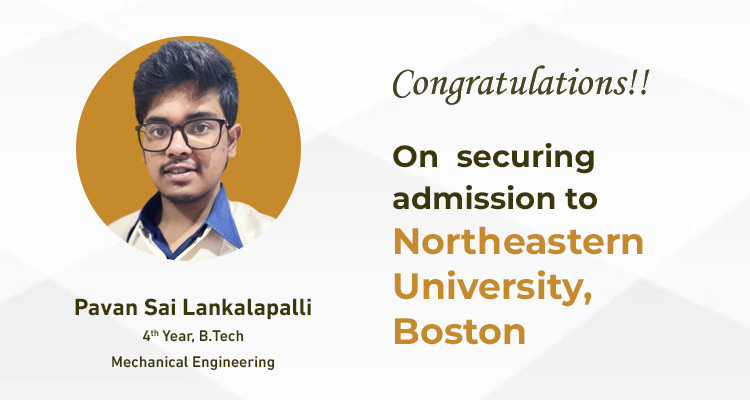 Lankalapalli Pavan Sai from the undergraduate department of Mechanical Engineering at SRM University-AP, Andhra Pradesh, has secured an astounding admission to Northeastern University (NEU), Boston for his higher education. The Master’s in Engineering Management programme that he has enrolled in meets F-1 international student status requirements and is purely designed for the Core background (i.e. Mechanical, Electrical, and Civil Engineering) students. Pavan Sai had also qualified to work with the global L&T Technology Services company through the campus placement at SRM University-AP.
Lankalapalli Pavan Sai from the undergraduate department of Mechanical Engineering at SRM University-AP, Andhra Pradesh, has secured an astounding admission to Northeastern University (NEU), Boston for his higher education. The Master’s in Engineering Management programme that he has enrolled in meets F-1 international student status requirements and is purely designed for the Core background (i.e. Mechanical, Electrical, and Civil Engineering) students. Pavan Sai had also qualified to work with the global L&T Technology Services company through the campus placement at SRM University-AP.
According to Pavan Sai, NEU lies in the heart of Boston city which is one of the major hubs for startups and the University is known for its CO-OP program that gives hands-on experience in theoretical, quantitative, and analytical skills and tools. His decision to study abroad happened rather late though he qualified IELTS on time and has been preparing for GRE.
When he applied to NEU just two days before the deadline, the faculty and staff at SRM University-AP extended their full assistance to go by the application. “I cannot forget the assiduous support and mentorship of my Professors Dr Satya Pramod Jammy and Dr Venkata Nori from the Department of Mechanical Engineering”, says Pavan Sai. “I also want to thank SRM University-AP for helping me and providing me with opportunities”, he adds.
- Published in Mechanical Engineering NEWS, News, Students Achievements
First private university to achieve twin foreign placement in maiden batch
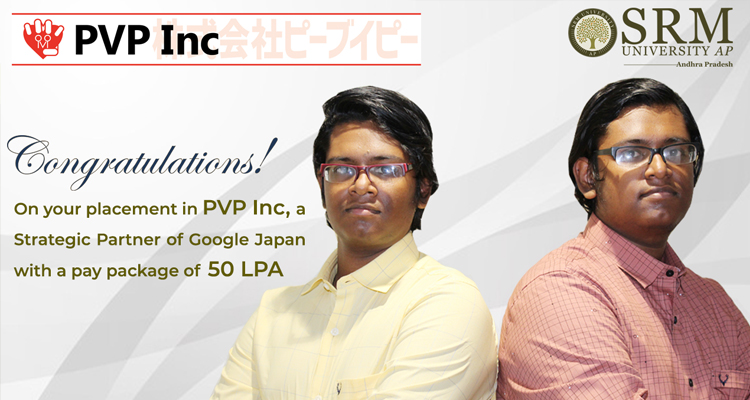 The prodigious twins of SRM University-AP proved their mettle again, cracking job offers with the highest salary of the season. Rajarshi and Saptarshi Mazumder from the Department of Computer Science and Engineering have been offered the positions of Technical Engineers-IT at PVP Inc Japan, a strategic partner of Google, Japan, with a pay package of 50 LPA. SRM University-AP becomes the first private university in India to achieve twin foreign placement in the maiden batch
The prodigious twins of SRM University-AP proved their mettle again, cracking job offers with the highest salary of the season. Rajarshi and Saptarshi Mazumder from the Department of Computer Science and Engineering have been offered the positions of Technical Engineers-IT at PVP Inc Japan, a strategic partner of Google, Japan, with a pay package of 50 LPA. SRM University-AP becomes the first private university in India to achieve twin foreign placement in the maiden batch
Coming from a small town in West Bengal, the twins joined SRM University-AP with dreams in their eyes. They struggled with their schooling due to the transferable nature of their father’s job, but it also prepared them with the mindset to overcome any obstacle that comes in their way to excellence. Rajarshi and Saptarshi found their educational abode in SRM University-AP, where their dreams and ideas were encouraged and nurtured.
“Every moment at SRM-AP was so defining. Academics and research, 24×7 student-run Next Tech Lab, Semester Abroad and Entrepreneurship at UC Berkeley, USA and winning Hackathon in Bay area competing with MIT, Stanford and Carnegie Mellon gave us the wide exposure of the real world, which would not have been possible without the continuous support of our faculty and university management. Now, it is time that we start our life in Japan, and we are very much looking forward to the new chapter,” said Rajarshi.
SRM University-AP is proud of its first graduating batch with a 100% Placement record, with most students getting multiple offers from reputed companies. 71% of students got Marquee, Super Dream, and Dream offers of ₹20+, ₹ 10+ and ₹ 5+ lakhs, respectively; and 600+ companies visited the university for recruitment. Top recruiters include Amazon, PayPal, Barclay, American Express, Bank America, Walmart, AB InBev, TCS, Cognizant, Infosys, L&T, AIS, JSW and Adani. The students of the Department of Computer Science and Engineering have bagged an attractive average salary of 8 LPA.
“SRM University-AP is founded with the vision to offer quality engineers, entrepreneurs and professionals to the country. In the Maiden Placement Drive itself, our graduates have shown predominance making the university a favourable destination for top industrial recruiters,” said Prof V S Rao, Vice-Chancellor, SRM University-AP.
Prof Ragunathan, Associate Dean in the School of Engineering and Sciences and Head of the Department of Computer Science and Engineering shared that our university has acquired the brand name as a prominent tech hub to the recruiters searching for the choicest engineers. “We are certain that in the coming years, the number of recruiters visiting will further increase, creating a record in the country”, he added.
Mr Vivekanandan, Assistant Director, Corporate Relations and Career Services, said that the department always looks for the best opportunities for the students. The aptitude of CSE students manifested in their internships, projects, curricular and extra-curricular endeavours naturally drew the attention of best recruiters to SRM University-AP.
- Published in CR&CS NEWS, CSE NEWS, News
No.1 Business School in Germany admits Aaditya Jain from CSE
 Here’s an exclusive interview with Aaditya Jain, a Computer Science Engineering graduate from SRM University-AP who has secured admission in ESMT Berlin, Germany.
Here’s an exclusive interview with Aaditya Jain, a Computer Science Engineering graduate from SRM University-AP who has secured admission in ESMT Berlin, Germany.
Q. Hi Aaditya, please tell us about yourself.
I am Aaditya Jain, a Computer Science Engineering graduate of Batch 2021 at SRM University-AP. I have always been fascinated by Business and Management and the impact that technology can bring about in transforming them. I have led AIESEC in Amaravati for 2 years and have done various internships in the field of Business & Management.
Q. Can you tell us your motivation behind applying to ESMT?
ESMT is a triple-accredited Business School, No.1 in Germany and No. 8 in Europe and No. 26 in the world (for its programme) according to ‘The Economist’, ‘Bloomberg Business’ and ‘Financial Times’- major ranking firms for the Business Schools. ESMT Berlin – European School of Management and Technology GmbH is located at the heart of Berlin, Germany. It is a business school founded by 25 multinational corporations including BCG, McKinsey, BMW, Allianz and others. I also applied to NOVA business school in Portugal, UCD Smurfit in Ireland and a few others.
Q. Can you talk about the course that you have enrolled in?
I would be pursuing a Master’s in Management (MBA) specialising in Global & Digital Strategy at ESMT Berlin, Germany. This is a 2-year programme with integrated Internships and Social Impact Projects launching my career into the field of Management Consulting/Marketing.
Q. Are you offered any scholarships there?
Yes, I am offered ‘Outstanding Student Leader’ scholarship of Euro 5500 by ESMT.
Q. How was your preparation for these university applications?
I always knew that I wanted a career in Management and Business. Right from my freshman year, I worked towards it. I started and led AIESEC in Amaravati (something highly valued by Business Schools), and I also did internships in the field of Marketing & Strategy. I made sure I get a pro-bono internship experience abroad and for that, I did an internship in Greece, Athens. I wrote my GMAT and at the same time, focused on my Essays. I think it’s all about being honest and genuine with yourself and others that count in the end.
Q. Can you elaborate on the support you received from SRM University-AP?
My university has immensely helped me in terms of both professional growth and financial assistance. I am grateful to SRM University-AP for providing me with sponsorship to attend my Master’s in these times of Covid-19 when everything is very uncertain. I am really thankful to Dr Srabani Basu who has helped me all throughout the 4 years of my journey at SRM AP. She mentored me, taught me business communication and interview skills, helped me develop my lateral thinking.
Q. What are your dreams about the future?
I want to work around the world, experience new cultures and be a pioneer in Digital and Strategic Transformation making sure the sustainable development of organisations. I also want to make sure that I impactfully and positively represent SRM University-AP wherever I go.
- Published in CSE NEWS, Departmental News, News, Students Achievements
Biochar for environmental sustainability in the energy-water-agroecosystem nexus.
 Biochar has an enormous potential in addressing global issues and can act as a catalyst in achieving sustainable development goals (SDGs). Dr Lakhveer Singh, Assistant professor in the Department of Environmental Science, SRM University-AP has co-authored and published a paper on the title “Biochar for environmental sustainability in the energy-water-agroecosystem nexus” in the research journal “Renewable and Sustainable Energy Reviews” with an Impact factor of 14.98.
Biochar has an enormous potential in addressing global issues and can act as a catalyst in achieving sustainable development goals (SDGs). Dr Lakhveer Singh, Assistant professor in the Department of Environmental Science, SRM University-AP has co-authored and published a paper on the title “Biochar for environmental sustainability in the energy-water-agroecosystem nexus” in the research journal “Renewable and Sustainable Energy Reviews” with an Impact factor of 14.98.
Global warming, management of soil health, remediation of contaminated wastewater, and sustainable alternate source of energy are the major challenges of the 21st century. Biochar produced from waste biomass (crop residues, algal biomass, municipal waste, etc.) has dual advantages of waste management along with its application in different sectors. Biochar addition to soil improves soil health, porosity and aeration which mitigates greenhouse gas emission from soil.
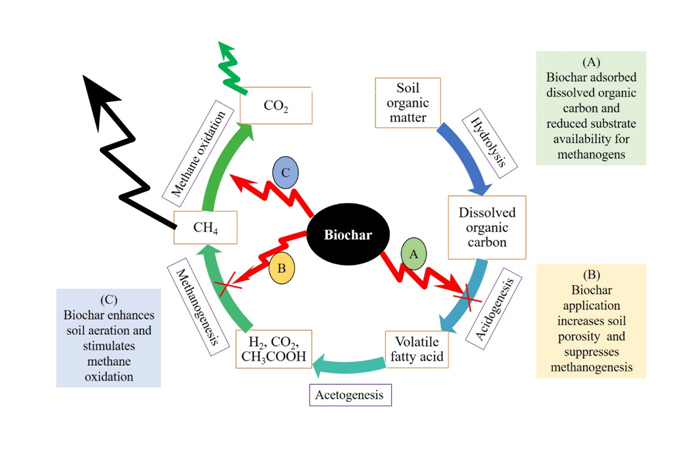 In this manuscript, Dr Lakhveer Singh discusses the potential of biochar for bioenergy production (biogas and biological hydrogen production), greenhouse gases mitigation, carbon sequestration in soils, and wastewater remediation are discussed in detail along with the challenges and future prospects of biochar. This work has been executed in collaborations with the National Institute of Hydrology, Jal Vigyan Bhawan, Roorkee; J.C. Bose University of Science and Technology; YMCA, Faridabad; and IIT Delhi.
In this manuscript, Dr Lakhveer Singh discusses the potential of biochar for bioenergy production (biogas and biological hydrogen production), greenhouse gases mitigation, carbon sequestration in soils, and wastewater remediation are discussed in detail along with the challenges and future prospects of biochar. This work has been executed in collaborations with the National Institute of Hydrology, Jal Vigyan Bhawan, Roorkee; J.C. Bose University of Science and Technology; YMCA, Faridabad; and IIT Delhi.
Dr Singh is an Editorial Board member of the Journal of Biomass Conversion and Biorefinery – Springer (I.F. 2.60) and a Guest Editor for Bioresource Technology Reports- Elsevier.
Read the full paper here: https://www.sciencedirect.com/science/article/abs/pii/S136403212100664X
- Published in Departmental News, ENVS News, News, Research News
Application-driven industrial-scale manufacturing of Li/Na-ion battery cathodes
 The advent of the industrial revolution increased the dependency of humans on fossil fuels which led to an increase in environmental degradation. While alternative energy sources such as wind, solar and hydro seem to be good options, their uncertainty in delivering the power made Dr Sujith Kalluri, Assistant Professor in the Electronics and Communication Engineering Department and his PhD scholar Chanakya Karra at SRM University-AP prefer batteries as a viable option. “Application-driven Industrial-scale Manufacturing of Li/Na-ion Battery Cathodes” is a paper published by Dr Sujith Kalluri and Mr Chanakya Karra in the Journal of The Electrochemical Society having an Impact Factor of 3.721 as part of their project to develop zero-emission energy methods.
The advent of the industrial revolution increased the dependency of humans on fossil fuels which led to an increase in environmental degradation. While alternative energy sources such as wind, solar and hydro seem to be good options, their uncertainty in delivering the power made Dr Sujith Kalluri, Assistant Professor in the Electronics and Communication Engineering Department and his PhD scholar Chanakya Karra at SRM University-AP prefer batteries as a viable option. “Application-driven Industrial-scale Manufacturing of Li/Na-ion Battery Cathodes” is a paper published by Dr Sujith Kalluri and Mr Chanakya Karra in the Journal of The Electrochemical Society having an Impact Factor of 3.721 as part of their project to develop zero-emission energy methods.
Through this article as a platform, the authors focus on three aspects of energy storage devices that are essential while the world is catapulted to upgrade itself from fossil fuels to electric vehicles. From a battery level perspective, they have discussed the dependence of the battery industry on lithium-ion technology and its repercussions. As a solution, they suggest the distribution of the dependency on sodium-ion technology owing to its adaptability and wide availability. From the cathode level perspective, the paper suggests co-precipitation through the CSTR as a customized solution to address the setbacks in the synthesis process and additive manufacturing as a preferred solution to cater for the desired electrode design specifications that would comply with the needs of future generations and the industry. Till the battery energy storage system paves the way for Na to take over, we can reckon on SC-NCM cathode material to serve the needs.
Read the full paper here: https://iopscience.iop.org/article/10.1149/1945-7111/abfab6/pdf
More about the Battery research project of SRM University-AP:https://srmap.edu.in/seas/electronics-and-communication-engineering/research-areas/battery-research/
- Published in Departmental News, ECE NEWS, News, Research News
Dr Nimai Mishra’s research group develops a new synthetic strategy to make ultra-stable CsPbBr3 perovskite nanocrystals for light-emitting application
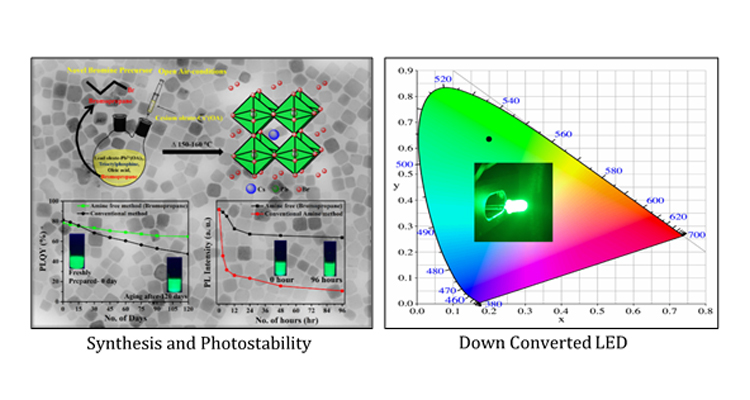 Dr Nimai Mishra, Assistant Professor in the Department of Chemistry, SRM University-AP, Andhra Pradesh, along with his research group comprising of students pursuing PhD under his supervision, Mr Syed Akhil and Ms V.G.Vasavi Dutt have published a research article titled “Bromopropane as a Novel Bromine Precursor for the Completely Amine Free Colloidal Synthesis of Ultra-Stable and Highly Luminescent Green-Emitting Cesium Lead Bromide (CsPbBr3) Perovskite Nanocrystals” in the Journal “Nanoscale” (The Royal Society of Chemistry, Impact Factor-7.8).
Dr Nimai Mishra, Assistant Professor in the Department of Chemistry, SRM University-AP, Andhra Pradesh, along with his research group comprising of students pursuing PhD under his supervision, Mr Syed Akhil and Ms V.G.Vasavi Dutt have published a research article titled “Bromopropane as a Novel Bromine Precursor for the Completely Amine Free Colloidal Synthesis of Ultra-Stable and Highly Luminescent Green-Emitting Cesium Lead Bromide (CsPbBr3) Perovskite Nanocrystals” in the Journal “Nanoscale” (The Royal Society of Chemistry, Impact Factor-7.8).
Recently, lead halide perovskite nanocrystals (PNCs) have attracted intense interest as promising active materials for optoelectronic devices. However, their extensive applications are still hampered by poor stability in ambient conditions. In this work, Dr Mishra’s research group report an open-atmospheric, facile, efficient, completely amine-free synthesis of caesium lead bromide perovskite nanocrystals using a novel bromine precursor, bromopropane, which is inexpensive, and available at hand. Their finding concludes that the PLQY can maintain 83% of their initial one even after 120 days. Furthermore, after 96 h of continuous irradiation by UV light with 365 nm (8 W/cm2) in the open ambient condition the photoluminescence (PL) intensity showed retention of 68% of its original value with no significant change in full width at half-maximum, whereas amine-based sample retains only 5% of its original PL intensity. Furthermore, Dr Mishra’s group has fabricated stable down-converted LED devices with these perovskite nanocrystals.
“More importantly, the present work demonstrates the synthesis of ultra-stable CsPbBr3 NCs which can be an ideal candidate for display applications”, says Dr Nimai Mishra.
Read the full paper: https://pubs.rsc.org/en/Content/ArticleLanding/2021/NR/D1NR03560F#!divAbstract
- Published in Chemistry-news, Departmental News, News, Research News
Dr Sarita Vig on “Wonders of Cosmos”
 Electronics and Communication Engineering (ECE) department of SRM University-AP in association with The Institute of Engineers (India), AP State Chapter and the Institution of Electronics and Telecommunication Engineers (IETE) Vijayawada Chapter has conducted a webinar titled “Wonders of Cosmos” on Saturday, April 17, 2021, at 3.00 pm through Zoom. The guest speaker Dr Sarita Vig from the Department of Earth & Space Sciences at IIST, Thiruvananthapuram, Kerala highlighted the basics of astronomy enlightening on the fundamentals and overview of the high-end telescopes found globally.
Electronics and Communication Engineering (ECE) department of SRM University-AP in association with The Institute of Engineers (India), AP State Chapter and the Institution of Electronics and Telecommunication Engineers (IETE) Vijayawada Chapter has conducted a webinar titled “Wonders of Cosmos” on Saturday, April 17, 2021, at 3.00 pm through Zoom. The guest speaker Dr Sarita Vig from the Department of Earth & Space Sciences at IIST, Thiruvananthapuram, Kerala highlighted the basics of astronomy enlightening on the fundamentals and overview of the high-end telescopes found globally.
Addressing the session, Dr CV Sriram, Hon. Secretary of IEI APSC opened the virtual podium to other dignitaries. Dr Geetha Devi from IETE introduced Dr Sarita Vig; Er. Kalee Prasad, Honourable Secretary; and Dr Ramanjaneyulu Fiete, Chairman of IETE. Dr Sujith Kalluri from the ECE department at SRM University-AP was the coordinator and organiser of the event.
Dr Sarita in her presentation elaborated on the different types of telescopes and observatories such as the CGRO, HST, SIRTF, CHANDRA. She discussed the elements responsible for the inception of the universe and the astrophysical processes behind it. Further, she talked about other planets which can be considered as a potential place for habitat like our earth. She also mentioned the supernova remnant crab nebula which was exploded billions of years ago and was even witnessed in the daylight, as per Chinese and Mexican researchers.
Towards the end of the session, Dr Sarita presented the facts about the black hole in the centre of the massive galaxy M87. “In 2019, Event Horizon Telescope helped to get the image of the black hole in radio wavelength. The universe is expanding and it is not in a static form,” she said. The webinar came to an end with an interactive Q&A session between the panellists and participants.
Controlled loading of MoS2 on hierarchical porous TiO2 for enhanced photocatalytic hydrogen evolution
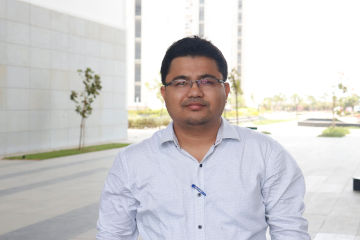 Ever since the breakthrough research on H2 photogeneration from water using TiO2 under UV-light irradiation, an enormous amount of research has been conducted on photochemical H2 evolution using different semiconductor-based photocatalysts. Consequently, a research paper titled “Controlled Loading of MoS2 on Hierarchical Porous TiO2 for Enhanced Photocatalytic Hydrogen Evolution” has been published by Prof Ranjit Thapa, Professor of Physics, SRM University – AP, as a co-author, in The Journal of Physical Chemistry C, having an Impact Factor of 4.189.
Ever since the breakthrough research on H2 photogeneration from water using TiO2 under UV-light irradiation, an enormous amount of research has been conducted on photochemical H2 evolution using different semiconductor-based photocatalysts. Consequently, a research paper titled “Controlled Loading of MoS2 on Hierarchical Porous TiO2 for Enhanced Photocatalytic Hydrogen Evolution” has been published by Prof Ranjit Thapa, Professor of Physics, SRM University – AP, as a co-author, in The Journal of Physical Chemistry C, having an Impact Factor of 4.189.
In this work, Prof Thapa describes three important factors for helping in the generation of hydrogen using proposed MoS2/TiO2 catalyst, (i) TiO2 for effective charge transfer, (ii) MoS2 for plasmon induction (iii) large surface area and active sites. It was shown that hierarchical porous TiO2 can be interfaced successfully with marigold-flower-like MoS2 flakes with intriguing photophysical properties, viz., visible-light response, controlled electron−hole recombination, and sustainable H2 production over prolonged light irradiation due to the synergic effect of flowerlike MoS2 and the fibrous wormhole mesoporous channel of TiO2. Further, the researchers have used density functional theory (DFT) to identify the active sites and calculated the change in Gibbs free energy (ΔGH). “We have also studied the charge density difference to understand about electron transfer pathway. The change free energy of hydrogen adsorption (ΔGH*) is a good indicator to estimate the hydrogen evolution activity in the acidic medium. From the DFT study, it is clear that O sites of MPT heterostructure are more favourable for HER reactivity”, said Prof Ranjit Thappa.
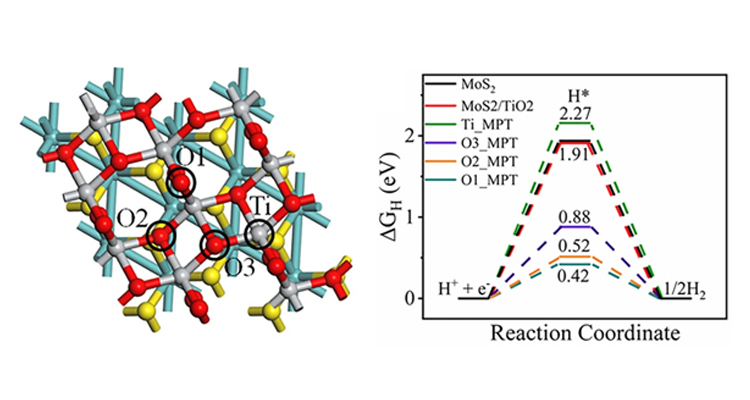
Social implications of the research:
In the last few decades, with the decline in non-renewable resources and increasing environmental pollution, significant attention has been given to renewable and clean energy domains. Hydrogen is considered one of the most suitable energy carriers due to its higher energy density per unit mass in comparison to other chemical fuels. In recent times, photocatalytic fission (Photocatalysis is a process in which light energy is used to drive pairs of chemical reactions. Through the absorption of light, an excited electron/hole pair is produced) of water has been considered an attractive solution for solar to chemical H2 energy conversion. Also, the process of water splitting is highly endothermic. Therefore, the development of an excellent, stable, efficient, and economical photocatalyst for ultrahigh H2 production efficiency is paramount to researchers.
This work is done in collaboration with the Department of Energy and Environmental Engineering, CSIR-Indian Institute of Chemical Technology, Hyderabad 500007, India.
Prof Ranjit Thapa is doing an investigation to find the possibility of hydrogen evolution reaction (HER) on multiple borophene analogues (α, β12, χ3) on all unique sites. Understanding the role of the coordination number of the boron atoms in the borophene analogues with the HER efficiency, and studying the pathways Volmer-Tafel (V-T) on each site to understand the completed HER process on borophene analogues are his future research projects. His research group is also interested to identify the role of sigma and pi-electron occupancy on the V-T pathway.
Read the full paper here: https://doi.org/10.1021/acs.jpcc.1c01922
- Published in Departmental News, News, Physics News, Research News
Ajay Sugandh secures admission to IIM Ranchi
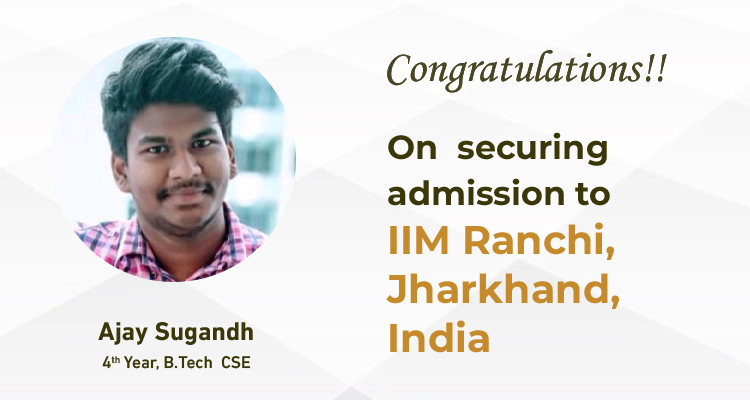 For Ajay Sugandh, securing admission to one of the prestigious Indian Institutes of Management (IIM) is a dream come true. Clearing the Common Admission Test (CAT) with a percentile of 90, he has bagged an admission offer at IIM, Ranchi. CAT is a national-level computer-based management entrance examination to reputed IIMs. More than 2 lakh candidates appear for the test and a few with a percentile of 90-99 secure a position on one of the IIM campuses.
For Ajay Sugandh, securing admission to one of the prestigious Indian Institutes of Management (IIM) is a dream come true. Clearing the Common Admission Test (CAT) with a percentile of 90, he has bagged an admission offer at IIM, Ranchi. CAT is a national-level computer-based management entrance examination to reputed IIMs. More than 2 lakh candidates appear for the test and a few with a percentile of 90-99 secure a position on one of the IIM campuses.
IIM Ranchi is a reputed business school established in the year 2009 and is the ninth IIM in the country. It holds the 10th rank in the NIRF ranking. The eligibility of the candidates is evaluated through CAT, followed by the written eligibility test (WAT) and Personal Interview (PI).
Ajay Sugandh is a CSE graduate hailing from Guntur, Andhra Pradesh. After completing an MBA from IIM, Ranchi, he wishes to pursue a career in Marketing. Ajay is trained by the TIME coaching institute that helped him crack the difficult test. He had prepared for a year and worked on soft skills, aptitude etc. His hobbies include watching movies and reading books.
Speaking of the support received from SRM University-AP, Ajay acknowledged, “Firstly, I am grateful to the faculty members of the Department of CSE who have been a constant support in reaching my goals. Secondly, the tremendous support from all my peers and family has encouraged me to manage my course CAT preparation together”.
- Published in CSE NEWS, Departmental News, News, Students Achievements
ECE students accomplish international internship in Canada
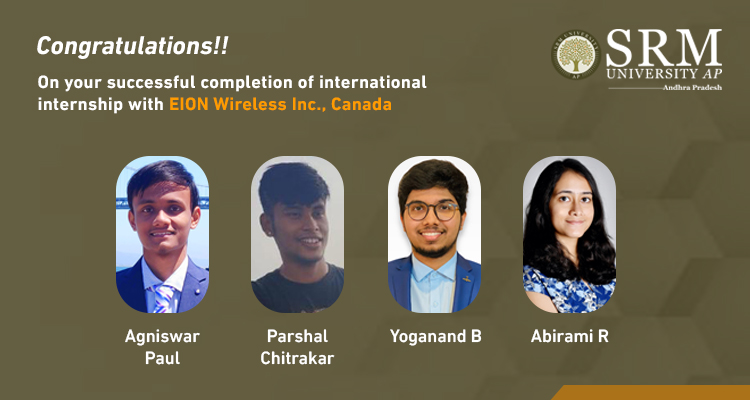 Yoganand B, Parshal Chitrakar, Agniswar Paul, Abirami Ravishankar are four brilliant students from the Department of Electronics and Communication Engineering at SRM University-AP who have successfully completed an international internship with EION Wireless Inc, Canada. The students worked as engineering interns with this reputed wireless solutions firm in Canada for five and a half months (Jan 15- June 30) obtaining an internship salary of 500 CAD per student every month. Through this opportunity, the students could build a system that is able to send data to long distances.
Yoganand B, Parshal Chitrakar, Agniswar Paul, Abirami Ravishankar are four brilliant students from the Department of Electronics and Communication Engineering at SRM University-AP who have successfully completed an international internship with EION Wireless Inc, Canada. The students worked as engineering interns with this reputed wireless solutions firm in Canada for five and a half months (Jan 15- June 30) obtaining an internship salary of 500 CAD per student every month. Through this opportunity, the students could build a system that is able to send data to long distances.
Selection Process:
a. Internal selection: Based on the CV and projects undertaken, the ECE Faculty conducted interviews and shortlisted the students.
b. Personal Interview: The shortlisted students attended the interview with the company in which, the company scrutinised their project, skills, and whether they were relevant to the company’s requirements.
c. Techincal Interview: This round focused on analysing technical skills. A technical problem statement was given to members and was asked to come up with a solution in 10 minutes.
d. Coding test: In this round, coding questions were distributed and students had to submit documents of output and on how the code was processed.
For engineering graduates, technical skills and hands-on experience with industry is inevitable. SRM University-AP ensures that every student grabs opportunities to excel in their respective disciplines.
Student Testimonial- Parshal Chitrakar:
I would like to thank the faculty of the ECE Department at SRM AP for this great opportunity. Being a part of this internship programme by EION wireless has been one of my first and best experiences in the industry. Being a fresher, this opportunity gave me a chance to apply my knowledge and skills in developing real-time applications. This five and a half months internship taught me different ways to look at things, work with people from diverse backgrounds, and helped me develop my technical as well as soft skills. Before this, I was focused only on personal achievements, but when we work for a company it has to be focused on the public demand and common good. I think this is the main difference between academia and industry. There is no such difference between academic-based projects and industry-based projects; it is just how we think, showcase our abilities and how our work reaches the target stakeholders.
- Published in Departmental News, ECE NEWS, News, Students Achievements

